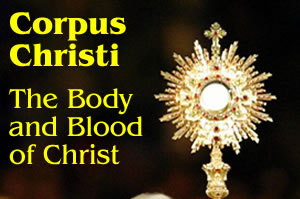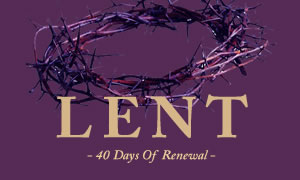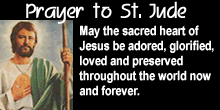


 The feast of Corpus Christi is one time when our Lord in the Blessed Sacrament is exposed not just to faithful Catholics but to all the world. This is a time when Catholics can show their love for Christ in the Real Presence by honouring Him in a very public way.
The feast of Corpus Christi is one time when our Lord in the Blessed Sacrament is exposed not just to faithful Catholics but to all the world. This is a time when Catholics can show their love for Christ in the Real Presence by honouring Him in a very public way.
It is also a wonderful way in which we can show our love for our neighbours by bringing Our Lord and Saviour closer to them. So many conversions are a result of Eucharistic Adoration experienced from inside the Church. How many more there would be if we could reach those who only drive by the church in worldly pursuits.
Establishment of the Feast of Corpus Christi
According to Canon Law (Can. 944 §1,2) "Wherever in the judgment of the diocesan Bishop it can be done, a procession through the streets is to be held, especially on the solemnity of the Body and Blood of Christ, as a public witness of veneration of the Blessed Eucharist. It is for the diocesan Bishop to establish such regulations about processions as will provide participation in them and for their being carried out in a dignified manner." Note that such processions can take place throughout the liturgical year but are "especially" encouraged on the feast of Corpus Christi. No other devotion has received such attention in the Code of Canon Law which shows the importance the Church attaches to this feast. It is one of the few feasts which is mentioned along with Holy Days of Obligation: "… the following holy days are to be observed: the Nativity of Our Lord Jesus Christ, the Epiphany, the Ascension of Christ, the feast of the Body and Blood of Christ, the feast of Mary, the Mother of God, the Immaculate Conception, the Assumption, the feast of St. Joseph, the feast of the Apostles Sts. Peter and Paul, and the feast of All Saints." (Can. 1246 §1)
The full name of this feast is Corpus et Sanguis Christi or The Body and Blood of Christ. "The feast of the Blessed Sacrament was established in 1246 by Bishop Robert de Thorte of Liege at the suggestion of St. Juliana of Mont Carvillon. [It was] extended to the universal Church by Pope Urban in 1264. The office composed by St. Thomas Aquinas and customary procession was approved by Popes Martin V and Eugene IV. Celebrated in June, the first Sunday after the feast of the Trinity." (Modern Catholic Dictionary, by John A. Hardon, S.J.)
St. Juliana, a Belgian nun in Retinne, lived at the time of St. Thomas Aquinas and St. Louis. She received this inspiration from Our Lord for the following reasons:
1) that the Catholic doctrine receive aid from the institution of this festival at a time when the faith of the world was growing cold and heresies were rife; 2) that the faithful who love and seek truth and piety may be enabled to draw from this source of life new strength and vigor to walk continually in the way of virtue;
3) that irreverence and sacrilegious behavior towards the Divine Majesty in this adorable Sacrament may, by sincere and profound adoration, be extirpated and repaired;
4) to announce to the Christian world His will that the feast be observed. (Full Brief of Pope Urban IV in The Blessed Eucharist, Fr. Michael Muller, C.S.S.R., 1867; republished by TAN Publishers, Rockford, IL 1994.)
After the last Mass on this feast day Our Lord is placed in the monstrance. The priest then carries Him to four different altars representing the four corners of the earth. While processing, the congregation follows and sings. At each altar there are readings, prayers, and benediction.
The Mass
The principal Mass of the solemnity of the Body and Blood of Christ is celebrated, according to local custom. In the homily, the theological and spiritual significance of the procession should be explained. Directions to assist the faithful to take part should be provided at the time of the homily or set out in the program with the hymns and acclamations to be sung during the procession, which should focus on the Lord.
At the fraction, the Host for the procession is either set apart on a paten or placed in the lunette (unless already consecrated in it). During Communion a server brings the empty monstrance to the altar, genuflects and places it to the left of the corporal. The missal and stand are removed. Hand candles are distributed and lit.
The deacon or, lacking him, the celebrant, goes to the altar, places the Host in the monstrance, sets the monstrance on the corporal and genuflects. The deacon then goes to the chair, where the celebrant sings or says the Prayer after Communion. The blessing and dismissal are omitted. At the chair, the celebrant may remove the chasuble and put on a white cope.
If the monstrance is heavy or the procession will be long, a sling may be put around his neck, over the stole, to take the weight of the monstrance. Directed by the M.C., the cross bearer and candle bearers take up a position in the aisle of the church, where they will lead the procession from the church. Concelebrants and other clergy follow them and line up in front of the altar, genuflect and then kneel.
The Eucharistic Procession
The public procession of the Eucharist should be promoted everywhere, especially in the light of the example of Pope John Paul II, who took the annual Corpus Christi procession from St. Peter's Square to the streets of Rome. However, such a procession must be carefully planned.
If it passes "through the streets", i.e., outside church property, it may be authorized by the diocesan Bishop, who should establish appropriate regulations to ensure respect for the Eucharist, a dignified celebration and full participation on the part of the people. What is described below for the solemnity of the Body and Blood of the Lord (Corpus Christi) may be used on other major occasions when this act of homage to Our Lord may also be celebrated, for example, "after a lengthy period of adoration." Such as the annual solemn exposition or Forty Hours devotion.
Everything is prepared as usual:
(a) for a solemn Mass with white vestments and
(b) for exposition of the Eucharist. Six or four candles burn on the altar. An extra priest's host is placed on the paten or prepared in a lunette, to be consecrated for the procession. The monstrance is ready on a credence table. Extra candles and flowers may be set up in the sanctuary to enhance the festive occasion. A white cope may be placed near the chair.
The route of the procession must be carefully defined. Well-placed loudspeakers and printed programs promote the full participation of the people-and help those watching the procession to be drawn into the celebration. In some countries, it is customary to decorate the houses and other buildings along the route. If the procession is long, the celebrant may stop at altars set up at convenient places where Benediction is given. The procession terminates with solemn Benediction, given either in or outside the church here it began, at another church or at some suitable place where the people can gather conveniently.
All kneel while a hymn of adoration is sung. Incense is prepared as at exposition, but in two thuribles. The Host is incensed as usual. Then the deacon or, if he is not present, a concelebrant or assistant priest goes to the altar with the celebrant. Both genuflect, and the deacon (concelebrant or assistant priest) places the monstrance in the celebrant's veiled hands. If he has no assisting clergy, the celebrant himself goes to the altar to take the monstrance in his veiled hands. If a sling is used, the deacon or the M.C. ensures that the monstrance rests securely in it, under the humeral veil.
All taking part in the procession stand. The celebrant turns or comes around to the front of the altar. His cope is held back by the deacon(s) as he slowly walks forward to an agreed point, where those bearing the canopy meet him and raise it over him and the deacon(s). The two thurifers and the boat bearer take their places in front of the canopy. As the first hymn begins, the procession proceeds in this order:
1. cross bearer carrying the cross or banner, flanked by the candle bearers;
2. religious associations, sodalities, etc., perhaps carrying their own banners;
3. religious in their habits; followed by First Communicants strewing flower petals;
4. the book bearer and corporal bearer;
5. the clergy, in choir dress (and copes);
6. the concelebrants of the Mass;
7. the two thurifers in front of the canopy customarily swinging the thuribles with their inside hands;
8. the people.
Directly under the canopy walks the celebrant, carrying the Eucharist devoutly at eye-level, with the deacon(s) beside and slightly behind him, holding back his cope, if necessary. No one else walks beneath the canopy. The torch bearers with torches or lanterns walk along each side of the canopy. According to local custom, an escort from the armed forces, the police, scouts or a Catholic youth movement, etc., may also flank the canopy, but arranged farther out from the torch bearers and carefully spaced so as not to obscure the celebrant as he carries the Eucharist.
Directed by the ushers in the church, the people who are to walk in the procession follow the canopy, taking part in hymns and acclamations. The singing is led by the choir and cantor(s) - either walking in the midst of the people or singing from a fixed point, with appropriate amplification. The procession should move at a slow and reverent pace. Identifiable marshals should control the ranks of a large procession, so that it does not become disordered. All those in the procession not already carrying something may carry hand candles. Children trained to strew flowers are arranged according to local custom, but they are not mingled with the clergy or servers.
As the procession goes through the streets or appointed area, the faithful not walking in it should kneel as the Blessed Eucharist passes by. As noted above, the procession may pause at suitably decorated "altars" for Benediction.
On returning to the church, or arriving at another church chosen and prepared for the final Benediction, the ceremonial escort, torch bearers and thurifers precede the canopy if the aisle is narrow. The canopy bearers stop in front of the sanctuary as the celebrant goes up to the altar. They move off to one side and put the canopy in a suitable place. The deacon takes the monstrance from the celebrant, places it on the corporal, and both genuflect. The M.C. or a server removes the humeral veil. Servers and torch bearers line up in the sanctuary for Benediction.
The celebrant and deacon(s) should wait until all the people have taken their places in the church and are kneeling. At a signal from the M.C., the hymn of adoration is sung, the Eucharist is incensed and Benediction is given as usual. Unless adoration is to continue, the Eucharist is reposed and a final hymn, acclamation or Marian antiphon may be sung. Clergy and servers proceed to the sacristy.
If the final Benediction is given in the open air, from the church steps, a balcony, or other place, these arrangements are adapted accordingly. The Benediction hymn begins only once all the people have gathered, kneeling or standing in an orderly way in the designated area. After Benediction the Eucharist is taken privately to the nearest tabernacle for reposition.


I have been thinking a great deal about my experience at Reconciliation this past Saturday. I felt an intense and unexplainable urge to go and confess my sins when I woke up that morning. I try to go every six weeks or so, but this was no routine visit to the priest for me. I needed to unburden myself of the numerous venial sins I had committed since I last participated in this Sacrament.
Purest Gold: God's Refining Fire in our Lives »
After salvation, many young Christians wonder if there's anything more to their newfound faith than just the security blanket of "being a Christian." Time and time again, God shows himself as a "refiner," and our lives are as gold. God started leading me in this study to understand what He was doing in my life, as well as in the lives of others.
Picking up my pen to write this column, I couldn’t imagine how time flies. Since the last publication of this column I have gone through a lot, especially the loss of my dear mother to whom I dedicate this article. Not only her, but seems I lost a whole generation of my close family.
How to Achieve Business Excellence »
“Do you see a man who excels in his work? He will stand before Kings; He will not stand before unknown men.” Proverbs 22:29
Spiritual Development for our Youth »
Most of us youth in today's fast moving world are easily thrown off by difficulties and worries.
The theme of conversion is a thread that runs all through Lent, but conversion takes on different aspects throughout the phases of Lent. The first two and a half weeks focused on the interior turning of hearts; the liturgy urges the faithful to reflect and examine consciences thoroughly.
Saint Josephine Bakhita »
Feast Day: February 8
Patron Saint Of: Sudan
Saint Josephine Margaret Bakhita was born around 1869 in the village of Olgossa in the Darfur region of Sudan. She was a member of the Daju people and her uncle was a tribal chief. Due to her family lineage, she grew up happy and relatively prosperous, saying that as a child, she did not know suffering.
Catholics Must Fast More Intensely This Lent»
The Norbertine Canons of St. Michael's Abbey have created this digital Lenten retreat so that you can journey through this holy season alongside them. If you want to have one of your best Lenten seasons yet, join us in our Lenten Program "The Great Fast" - https://theabbotscircle.com/the-great-fast-join
When Your Faith Is Put to the Test - Bishop Barron's Sunday Sermon»
Friends, we come now to the Second Sunday of Lent, and we’re on both dangerous and very holy ground with the first reading from the twenty-second chapter of Genesis. The ancient Israelites referred to it as the “Akedah,” which means the “binding”: Abraham binds and is ready to sacrifice Isaac at God’s command.

Copyright © 2002-2024 THE BEACON INTERNATIONAL CATHOLIC MAGAZINE. All rights reserved.
another mc.rufus interactive web design